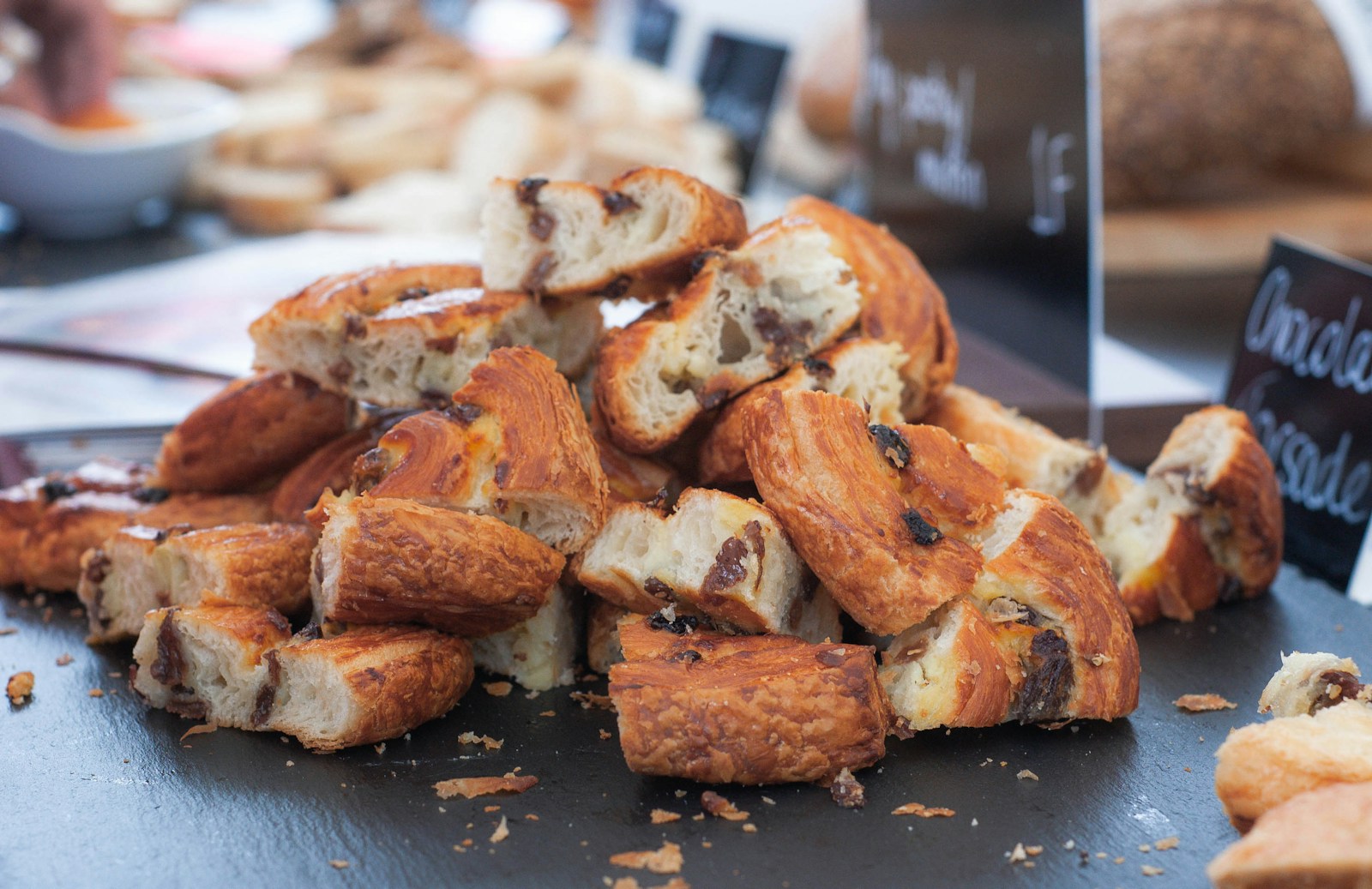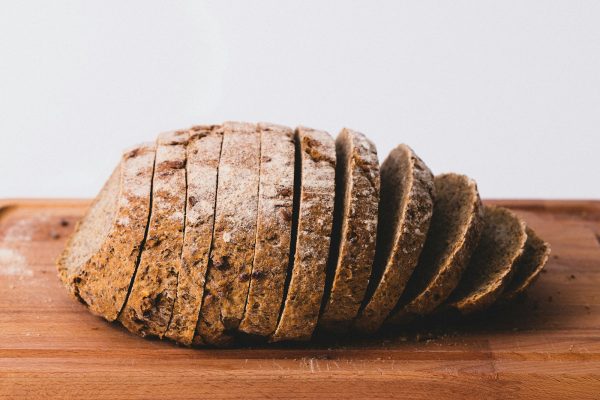Click to Skip Ahead
Humans have enjoyed bread since ancient times. It is a staple in most households, and we’ve derived so much pleasure from eating it. But if you’ve been thinking about sharing some with your dog, you want to ensure dogs can eat bread safely.
For the most part, certain kinds of bread are perfectly safe for dogs in moderation. But bread that contains ingredients like raisins and garlic is highly toxic and should never be given to a dog.
In this article, we’ll discuss if dogs can eat bread, the best ways to serve it and list the types you must avoid at all costs.
Why Can’t Dogs Eat Bread?
It all depends on the kind of bread that you offer your dog and how much. Plain wheat and white bread are usually safe for dogs that don’t have food allergies, specifically to wheat.
But while dogs can eat bread, it doesn’t mean that bread is good for dogs, nor does it offer any real nutrition. Certain types contain ingredients that are toxic to dogs and must be avoided.
The 6 Dangerous Types of Bread
There are health problems that can occur if a dog is given bread to eat on a regular basis. Bread is quite high in carbohydrates, which can lead to obesity and increased risk for medical conditions like joint problems, pancreatitis, and even cancer. There are also specific types of bread that you should keep away from your dog at all costs.
1. Bread Dough

If you make your own bread regularly, you must ensure that your dog can’t access any of your bread dough. The yeast in many bread doughs will continue to rise in a dog’s warm and moist stomach, which can lead to bloat, which can then quickly lead to the life-threatening gastric dilatation-volvulus. In addition to this, when the dough rises, it goes through a fermentation stage, which can cause alcohol poisoning in dogs.
If your dog eats dough, you must bring them to your veterinarian immediately or the closest emergency veterinary clinic.
Signs that your dog may have ingested bread dough can include:
- Distension of the stomach (bloat)
- Dry heaving
- Vomiting
- Lethargy
- Impaired walking and reflexes
- Disorientation
- Incoordination
- Weakness
- Hypothermia
- Seizures
- Coma
- Death
2. Garlic Bread

Garlic bread is bad for dogs and should be avoided at all costs. Everything in the garlic and onion family, including chives, leeks, and green onions, is highly toxic to dogs. This includes onion or garlic powder, which is actually worse than fresh forms because it is more potent. There’s also the excess butter found in garlic butter, which won’t do your dog any favors.
The following signs can occur if a dog eats anything with garlic or onions:
- Lethargy
- Vomiting
- Diarrhea
- Pale gums (anemia)
- Cyanosis (blue skin and gums)
- Increased respiratory rate
- Increased heart rate
- Red or brown urine
- Excessive drooling
If not treated, even a small amount of garlic can be fatal. If your dog ate anything with onions or garlic, seek medical help immediately!
3. Raisin Bread

Raisins are also toxic to dogs. They are essentially concentrated grapes, which is what makes them so toxic. If a dog eats raisins, it can lead to kidney failure, but it’s variable how many raisins can lead to this. For this reason, it’s best not to give your dog even just one.
Signs of raisin toxicity can include:
- Vomiting
- Diarrhea
- Increase in water consumption
- Increased or decreased urination
- Loss of appetite
- Weakness
- Lethargy
- Dehydration
- Bad breath (ammonia smell)
If your dog ate raisin bread or anything with raisins or grapes, let your vet know that you’re on the way and get your dog immediate medical help.
4. Banana Bread

Bananas are perfectly healthy snacks for dogs, but the other ingredients that tend to appear in banana bread are less healthy. Banana bread usually has a large amount of sugar and butter, which isn’t healthy for our pets. Certain varieties also have nuts, and any nut with mold is quite toxic. Furthermore, some nuts are safe for dogs, while others aren’t.
The nuts that you must avoid giving your dog are:
- Black walnuts: Highly toxic but not commonly used
- Macadamia nuts: Highly toxic to dogs
- Pistachios: Not toxic but a potential choking risk
- Almonds: Also safe but a choking hazard
Beyond this, nuts are high in fat and calories. If dogs eat nuts regularly, the risk is obesity and pancreatitis. Banana bread can also contain chocolate, which is toxic, as is the natural sweetener xylitol.
5. Pumpkin Bread

Like with banana bread, pumpkin is healthy for dogs, but pumpkin bread contains ingredients that are unhealthy. One ingredient commonly used in pumpkin bread is nutmeg, which is toxic. A slice of pumpkin bread likely doesn’t have enough nutmeg to cause serious problems, but you should still know that as little as 1 teaspoon is toxic to dogs.
Signs of nutmeg poisoning might include:
- Diarrhea
- Vomiting
- Lack of appetite
- Hallucinations
- Disorientation
- Stomach pain
- Fever
- Seizures
If your dog ate something with nutmeg, contact your veterinarian for next steps.
PangoVet. It’s an online service where you can <b>talk to a vet online</b> and get the personalized advice you need for your pet — all at an affordable price!
</p>
<div class="su-button-center"><a href=https://www.dogster.com/dog-nutrition/"https://pangovet.com/?utm_source=dogster&utm_medium=article&utm_campaign=dog_eat_drink%22 class="su-button su-button-style-default" style="color:#FFFFFF;background-color:#FF6600;border-color:#cc5200;border-radius:9px;-moz-border-radius:9px;-webkit-border-radius:9px" target="_blank" rel="nofollow"><span style="color:#FFFFFF;padding:0px 24px;font-size:18px;line-height:36px;border-color:#ff944d;border-radius:9px;-moz-border-radius:9px;-webkit-border-radius:9px;text-shadow:none;-moz-text-shadow:none;-webkit-text-shadow:none"> Click to Speak With a Vet</span></a></div></div></div>"}" data-sheets-userformat="{"2":513,"3":{"1":0},"12":0}"> If you need to speak with a vet but can’t get to one, head over to PangoVet. It’s an online service where you can talk to a vet online and get the personalized advice you need for your pet — all at an affordable price!

6. Gingerbread

Gingerbread contains the usual suspects of sugar and butter and the toxic nutmeg.
Safe Bread for Dogs
Giving bread to your dog as a regular part of their diet is generally not recommended.
If you want to give your dog an occasional piece of bread, the following breads can be considered safe but only after you’ve double-checked the ingredients for anything toxic.
- White bread: This is safe for dogs but has no nutritional value whatsoever.
- Whole wheat bread: It has fewer calories and more nutritional value than white bread. It is also higher in fiber.
- Cornbread: It’s not a yeast bread, which makes it safer, but it’s high in carbs, salt, and sugar.
- Rye bread: Whole grain rye bread is one of the healthier options because it’s high in fiber and has less gluten.
- Sourdough bread: It must be baked thoroughly; raw sourdough can cause serious health issues.
- Pita: Plain pita is quite safe for dogs in small amounts.

What Should You Do If Your Dog Eats Bread?
If your dog ate one of the safe breads without toxic ingredients, they will likely be fine. But if they eat a large amount of it, they might experience an upset stomach—it’s a good idea to touch base with your vet, anyway. But if your dog eats bread with toxic ingredients, call your vet, and let them know that you’re on the way. You should bring some of what your dog ate with you if you can. It will allow the vet to treat your dog appropriately.
You can also call the Pet Poison Helpline at (855) 764-7661 or the ASPCA Animal Poison Control Center at (888) 426-4435. There is a fee, but they can help you with any necessary steps that you should take before going to your veterinarian.
Conclusion
Bread really isn’t a food item meant for dogs to eat. It offers them little nutritional value, and many kinds of bread are toxic to canines.
When it comes to people food, the ingredients should always be checked carefully before giving anything to your dog. But if your dog has a wheat allergy, generally has a sensitive stomach, or has a health condition like obesity or diabetes, avoid giving your dog any type of bread.
If your dog snatches some of your bread on the safe list, they will likely be okay. But see your vet if you’re worried about any of the ingredients.
Featured Image Credit: Jude Infantini, Unsplash













